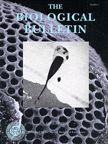| |
Fertilization
in Callochiton castaneus (Mollusca)
John Buckland-Nicks1
& Alan H. Hodgson2
Biol.Bull. 199(Aug.2000)
59-67
1.Department of Biology, St Francis
Xavier University, PO Box 3000, Antigonish, Nova Scotia, Canada, B2G 1C0
2. Rhodes University, Department
of Zoologoy and Entomolgy, Grahamstown 6140, South Africa

|
| 1 |

|
Abstract
A
fine structural study of fertilization in Callochiton castaneus has revealed
that the mechanism of sperm penetration into the egg is intermediate between
the primitive condition found in members of the Order Lepidopleurida and
the more derived condition found in the Chitonida. C. castaneus sperm have
the long needle-like nuclear filament and reduced acrosome that characterizes
all Chitonida but have retained several plesiomorphic features such as
an unspecialized mid-piece and lack of flagellar reinforcement. Like some
Lepidopleurida but unlike any other Chitonida, the egg hull comprises a
thick, smooth jelly coat that is permeated by pores that permit sperm rapid
access to the vitelline layer. The jelly coat is delicate and quickly dissolves
when a sperm concentrate is used, suggesting that excess acrosomal enzymes
may be responsible. Once the sperm have penetrated the vitelline layer,
the long nuclear filament bridges the gap to cups in the egg membrane.
However, once the fertilization membrane is raised the perivitelline space
exceeds the length of the nuclear filament, preventing other sperm from
penetrating the egg. A fertilization cone forms around the penetrating
sperm nuclear filament but does not appear to engulf the body of the sperm.
Rather, the nuclear chromatin is injected into the egg as a long thread.
The remaining sperm organelles may be abandoned on the egg surface. If
this is the case it would be a significant departure from fertilization
in other molluscs and many other metazoans, in which sperm organelles,
such as centrioles and mitochondria, enter the egg.
New sperm
and egg characters as well as significant differences in fertilization,
indicate that Callochitonidae are basal to all other members of the Order
Chitonida and may warrant separation as the sister taxon to the Suborders
Chitonina and Acanthochitonina.
For a reprint of this article,
please e-mail jbucklan@stfx.ca
|


